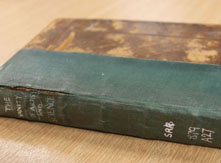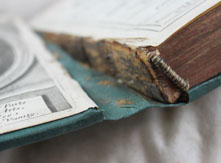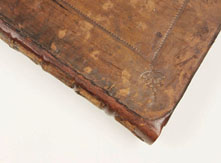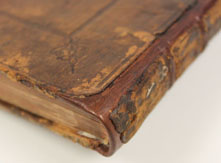Adopt-a-Book
An Initiative of the Friends of the University of Adelaide Library
The vanity of arts and sciences.
Heinrich Cornelius Agrippa von Nettesheim (1486-1535)
London: Printed by R.Everingham for R.Bentley, 1684
Rare Books & Special Collections
Strong Room Collection SR 879 A27
We thank our donor...
Conservation treatment of The vanity of arts and sciences was generously funded by Adopt-a-Book donor, Barbara Kidman. Her valued contribution has ensured that this 17th century scholastic work will be available for future generations of researchers for many years to come.
Synopsis
Born in Cologne, Germany, in 1486, Heinrich Cornelius Agrippa von Nettesheim was a man of many talents. A physician, legal scholar, soldier, theologian and author (particularly in occult philosophy), Agrippa took his name from both his birthplace (Colonia Agrippina) and the origin of his family, Nettesheim, a small town north-west of Cologne. Though little has been documented about his childhood, it’s widely believed that Agrippa’s teenage years were spent studying law, medicine, theology and magic sciences at the University of Cologne. Between 1508 to 1509 and 1511 to 1518 he also pursued military interests, travelling to Spain on a secret mission and serving Maximilian in Italy. His academic career flourished during this time as well; he lectured in Paris on Johann Reuchlin’s De verbo mirifico, held theological debates at Cologne and finished the first draft of De occulta philosophia (On the occult philosophy), 1510.
In 1518 Agrippa secured the position of advocate and orator at Metz, a city in the north-east of France. His new religious ideas, however, led to conflict with the monks there. Whilst defending a woman accused of witchcraft may have won him the esteem of several colleagues, it did little to improve the situation with religious authorities and essentially led to his resignation from office. The publication of some of his writings only exacerbated the disdain within his enemies, and disparaging comments about the Queen Mother ultimately resulted in his arrest in France.
An unrelenting interest in the occult sciences saw Agrippa continue to write openly about his beliefs. He proffered that God had created several worlds, three of which constituted the All: the domain of the elements, the heavenly world of the stars, and the intelligible cosmos of the angels.[1] At the centre of these was man, who, as a microcosm and therefore a mirror image of the macrocosm, could obtain knowledge of everything.[2] Essentially, the effectiveness of magic, was based on the connection between the three worlds and only the human spirit could reveal the hidden forces present in matter.[3] His ideas differed significantly from those of his predecessors, for he also recognised the intrinsic risk of each form of magic, be it natural, astrological or ceremonial. Magic based on physics (natural) could not be checked and, as such, was limited in its powers; astrological magic was often false and confused, and ceremonial magic was superstitious, complicated and at times dangerous.[4]
In The vanity of arts and sciences, Agrippa considers at length how “pernicious” and “destructive” the arts and sciences can be to the “well being of Men, or to the Salvation of our Souls.” He goes on to state that the arts and sciences are in fact so far from being extolled with “such high applauses” that they should actually be “disprais’d and vilifi’d”. Having often been criticised for the paradoxes of his philosophical claims, it’s clear here that Agrippa ultimately rejected the expertise of the mind in favour of immediate experience and revelation by God, if not through magic, then through faith in scripture or in the Holy Spirit.[5] The vanity of arts and sciences considers this view in the context of anatomy, astrology, grammar, dreams, husbandry, law, mathematics, optics, painting and witchcraft amongst many others.
Original Condition
Significant green cloth repair to spine, covering almost half of front and rear boards. During repair, rear board placed upside down in error, resulting in damage to what was actually the fore-edge side, not the joint side. Cloth repair itself deteriorating, pulling leather away from spine. Both boards detached and textblock split between the frontispiece and title page. Headbands loose and board corners separating due to significant loss of leather. Requires a full reback.
 |
 |
 |
 |
 |
 |
Restoration by Anthony Zammit
Previous green cloth repair removed, including glue residue. Damaged leather cover sympathetically dyed to match existing leather. Rear board placed correctly and new spine created. Remaining leather from original spine reattached to new leather. Board hinges reinforced with Japanese repair paper. Separated board corners consolidated and re-covered with new leather. Frontispiece and front endpaper tipped in again, also with Japanese Kozo paper.
 |
 |
 |
 |
 |
 |
Footnotes:
[1] Schmitz, R., ‘Agrippa, Heinrich Cornelius’, Complete Dictionary of Scientific Biography, 2008, accessed online 13 November 2017, http://www.encyclopedia.com/people/philosophy-and-religion/other-religious-beliefs-biographies/henricus-cornelius-agrippa
[2] As above
[3] As above
[4] Compagni, Vittoria Perrone, "Heinrich Cornelius Agrippa von Nettesheim", The Stanford Encyclopedia of Philosophy, Spring 2017 Edition, Edward N. Zalta (ed.), https://plato.stanford.edu/archives/spr2017/entries/agrippa-nettesheim/
[5] Friesen, Ryan Curtis, ‘Supernatural fiction in early modern drama and culture’, Renaissance Quarterly, 2010, pp.1003-4




